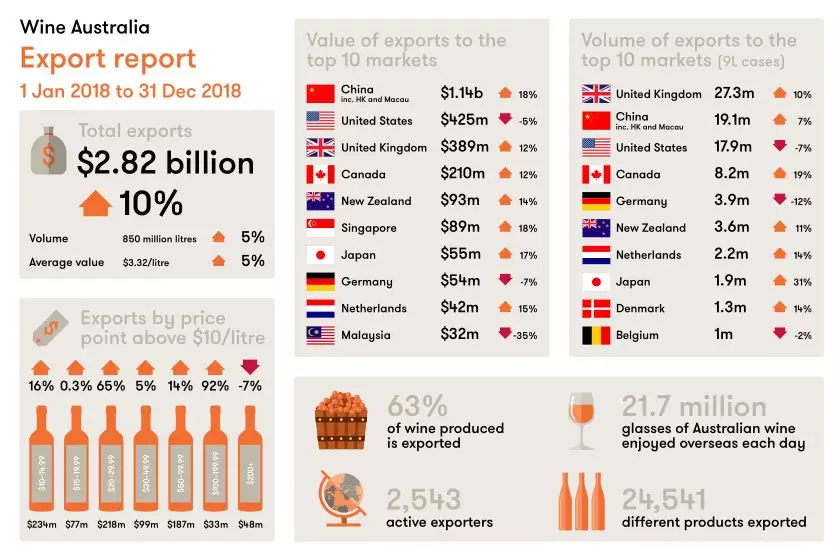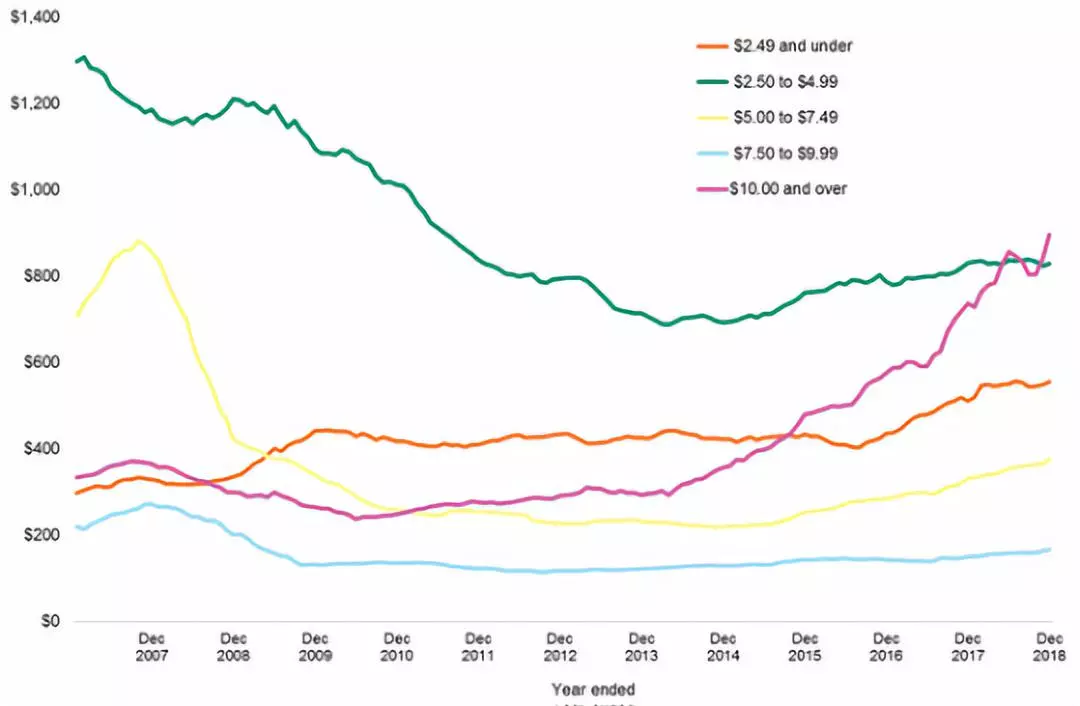On January 22, 2019, the Australian Wine Authority (Wine Australia) released the latest export report. The report shows that Australian wine exports continue to grow in the global market, and demand for fine wines is strong.
For the year ended December 31, 2018, Australian wine exports to the world increased to A$2.82 billion (equivalent to RMB 13.664 billion), an increase of 10% year-on-year, and exports also reached a new high, increasing 5% to 850 million liters. The average FOB price of Australian wines was 3.32 Australian dollars per liter, an increase of 5%.
Among them, the total export volume of China, Hong Kong and Macao was 1.14 billion Australian dollars (equivalent to 5.53 billion yuan), an increase of 18%. The US market declined slightly, ranking second with A$425 million. Although the UK market ranked third in terms of exports for A$389 million, it was the leader in exports.

The Australian Bureau of the Grapes official website shows that Australian wines have achieved extraordinary results in exporting to China over the past decade, and the implementation of the China-Australia Free Trade Agreement in 2015 has driven the already strong market. In terms of exports, mainland China is the preferred destination for Australian wine exports and has grown from A$73 million in 2007 to A$846 million in 2017. Hong Kong, China, also experienced strong growth during this period, from A$36 million to A$118 million, while Taiwan from China increased from A$10 million to A$13 million.
Australian wines rank second in China’s market share, second only to France, but the average price of bottled wines ranks first. Research conducted by Wine Intelligence on behalf of Wine Australia shows that since 2013, the number of Australian wine drinkers in the Chinese market has doubled. China’s tourism industry has also provided new opportunities for the growth of Australian wines. In 2017, there were more than 1 million Chinese tourists.
Andreas Clark, CEO of the Australian Wine Authority, said, “These figures show strong international demand and highlight the efforts of Australian wine exporters to develop and maintain the international market, and this demand is reflected in the growth of almost all price ranges. It is.”
In 2018, the export volume of Australian bottled wine increased by 7% to A$2.24 billion, and the export volume was slightly reduced by 3% from 361 million liters. But the average FOB price of bottled wines has increased by 10% to a record level of A$6.20/L.
Bottled wines also performed well, creating a record high, with exports increasing by 27% to A$560 million, exports increasing by 12% to a record value of 480 million liters, and the average FOB price of bottled wines also increasing. 14% to 1.17 AUD / L.
Export price of each price range (FOB) in 2018
(in millions of Australian dollars)

Another new record is that the export price of FOB 10 AUD/L or more has increased by 22%, reaching 895 million Australian dollars, exceeding the export value of 2.50-4.99 AUD/L, and the price range of 2.50-4.99 AUD/L has been long. Occupy the largest export share in history.
Trends in the export volume of various price ranges (FOB) in 2007-2018
(in millions of Australian dollars)

Red wine is still the most exported wine type in Australia. In the past year, red wine exports have increased by 12% to A$2.14 billion. White wine exports increased by 10% year-on-year to 607 million Australian dollars.
In 2018, Australian wines have almost increased their exports to each region. Among them, the North American market began to stabilize after more than 12 months of decline.
Exports by region:
Northeast Asia increased by 19% to A$1.23 billion
North America fell 0.1% to 636 million Australian dollars
Europe grew by 7% to A$615 million
Southeast Asia grew by 3% to A$171 million
Oceania grew by 12% to A$105 million
Middle East grew by 36% to A$33 million
It is understood that Australia is the world’s fifth-largest wine exporter with a total vineyard area of approximately 135,000 hectares and more than 100 different grape varieties, with exports accounting for approximately 60% of its total production.


